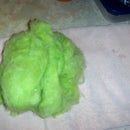Introduction: How to Recycle an Old Sweater (or a Botched One) Into Usable Yarn
Do you have old sweaters laying around? Is the yarn simply gorgeous or do you just want to re-use it? Is the sweater to mishapen to wear or just plain ugly, but the yarn is excellent? Did make an absolutely marvelous sweater, only to try it on and discover you should burn the pattern? Well then, recycle that yarn!!!
There are two methods of recycling a sweater into re-usable yarn. The first method is done from a work-in-progress (wip), the second method is done from an already finished-object (fo).
Step 1: Remove the Needles
Here, we will begin by removing the needles from the offending sweater. This is done by simply sliding the stitches off of the needles.
Then, lay the offending sweater flat sew you can begin frogging. Frogging is the process of ripping the stitches out: As in, "Rip it, rip it, rip it!"
Step 2: Frog It!!
Begin frogging by grasping the unknit yarn and carefully rip out all of the stitches of the sweater. You will have to undo all of the yarn ends that were woven in, before you come to them (I don't hide my ends until I'm satisfied with it when I try it on.). This can be done by using a blunt tapestry needle to fish out the woven in ends. Also undo any knots you come across.
As you rip out the stitches, gently wind the yarn into a ball.
Frequently remind yourself that you will not knit clothes that will not fit you like the model in the picture, unless the model in the picture has a similar form to your own.
Step 3: Continue Frogging the Sweater.
Keep pulling the yarn out and winding it into a ball as you go.
Wind gently so you do not stretch the yarn out anymore than it is already. This is especially important if you are unraveling a cotton, silk or wool sweater.
Step 4: Locating the Seams of a Finished Sweater to Frog (rip It).
Pictures 1 & 2 demonstrate some typical sweater seams you may come across when you're recycling yarn from an old sweater or a thrift store find.
The arrows in 3rd picture show the seams in a knit vest that was way too small for my son.
If the seams are super snug, take a pair of scissors with very sharp points and carefully slide a point underneath one of the seam stitches and snip it. Make sure you do not cut into the knitted portions of the sweater. Picture 4 shows the snip being made.
Step 5: Continue Unseaming the Knit Object.
Continue using your blunt tapestry needle as shown in the pictures to gently lift out the seam stitches. Use your scissors to snip off the seam yarn as you go.
Do this to every seam in the knit object. Then lay out your pieces as flat as possible.
Step 6: Locate Where the Knitting Was Cast Off.
This step is tends to be very difficult for some people, so I will try to make it as easy as possible. I have not used photos from the vest because the yarn prevented good, defining photos. Pic 1 is a 4 inch x 4 inch swatch of silk.
A piece of knitting has a cast on edge (where the knitting was started) and a cast off edge (where the knitting was finished). The cast on edge is usually comprised of what looks like a straight row of stitches (Pic 1). The cast off edge looks like a series of V's (Pic 2).
The end you want to rip from, is the end that looks like a row of V's across it's top or bottom. Remember, most sweaters and knit objects are knit from the bottom up, so your cast off edge will usually be near the top.
Step 7: Find the End Stitch and Undo the Finishing Knot.
Now, find the very last, cast off stitch. This will typically be on the front side of the knitting(the knit side) at the left end. (Note: If you see the v's going in the opposite direction as those in pic 5, flip it over and look for the end knot there.)
Pics 1 & 2 show the locating of the finishing knot on the knit side of the swatch and the undoing of it.
Pics 3, 4, & 5 show the yarn being liberated from it's knot. Now you can rip out the knitting as shown in steps 2 & 3.
Step 8: Enjoy and Use Your Recycled Yarn
I typically let the yarn rest in the balls for a few days before I begin re-using it. Simply knit, crochet, or weave it into something new!!!
Participated in the
Discover Green Science Fair for a Better Planet













